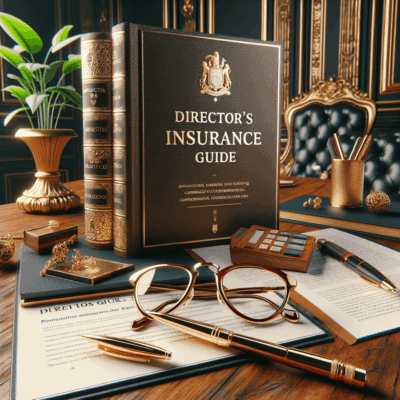The Impartial Guide to Directors Insurance: An Expert’s Advice on How to Compare Insurance Policies
Navigating the complex landscape of corporate leadership is a role fraught with immense responsibility and, inevitably, significant risk. In an era of heightened regulatory scrutiny, volatile markets, and an increasingly litigious environment, the decisions made in the boardroom can have profound personal consequences for those sitting around the table. This is where the critical safeguard of Directors and Officers (D&O) Insurance comes into play. For any director or officer, understanding this specialized coverage is not merely a prudent financial step; it is an essential component of sound corporate governance and personal risk management. This comprehensive guide, crafted from an expert perspective, will provide an impartial deep dive into directors insurance, equipping you with the knowledge to effectively compare insurance options and secure the protection you and your organization truly need.
Understanding the Core Concept: What is Directors and Officers Insurance?
At its heart, D&O insurance is a liability policy designed to protect the personal assets of a company’s directors, officers, and sometimes, its employees. It serves as a financial backstop, covering the costs associated with defending against lawsuits and paying settlements or judgments that arise from alleged “wrongful acts” committed in their capacity as leaders of the organization.
A common misconception is that a company’s general liability policy covers these executive actions. It does not. General liability covers bodily injury or property damage, while D&O insurance covers “management liability”—the financial and reputational harm stemming from strategic decisions.
Key Exposures and “Wrongful Acts”
What exactly are directors and officers being sued for? The spectrum is broad, but common allegations include:
- Breach of Fiduciary Duty: Claims that a director failed to act in the best interest of the company, such as mismanaging assets, failing to disclose material information, or engaging in self-dealing.
- Misrepresentation: Allegations of providing inaccurate or misleading information to shareholders, investors, or regulators.
- Failure to Comply with Laws or Regulations: Lawsuits stemming from violations of securities laws, employment laws, environmental regulations, or other statutory duties.
- Poor Corporate Governance: Claims related to inadequate oversight, lack of internal controls, or negligent decision-making that leads to financial loss.
- Employment Practices Liabilities: While often covered under a separate EPLI policy, many D&O claims involve alleged wrongful termination, discrimination, or harassment by management.
These suits can be brought by a wide range of parties: shareholders, employees, competitors, creditors, customers, and regulatory bodies like the Securities and Exchange Commission (SEC).
The Anatomy of a D&O Insurance Policy: Side A, B, and C
An expert understanding of a D&O policy requires familiarity with its standard structure, which is typically divided into three “Sides” or coverage parts.
Side A: Non-Indemnifiable Loss Coverage
This is the most critical component for the individual director or officer. Side A pays directly for losses when the company is legally unable to indemnify its executives. This can happen if:
- The company is legally prohibited from indemnifying them (e.g., by state law).
- The company is financially insolvent or bankrupt and has no funds to provide indemnification.
Side B: Corporate Reimbursement Coverage
This is the most commonly triggered part of the policy. When a company is legally permitted and financially able to indemnify its directors and officers (as most corporate bylaws require), it does so. Side B then reimburses the corporation for those defense costs, settlements, and judgments. This protects the company’s balance sheet from the financial impact of defending its leadership.
Side C: Entity Securities Coverage
Also known as “Entity Coverage,” Side C extends protection to the company itself for claims made against it, typically only in the context of securities lawsuits (e.g., when shareholders sue the company alongside its directors and officers for a drop in stock price). This is particularly relevant for publicly traded companies. For private companies, entity coverage is often broader and can be a crucial negotiating point.
The Imperative of an Impartial Approach: Why Objectivity is Non-Negotiable
When navigating the D&O market, the stakes are too high to rely on anything less than a completely impartial and objective analysis. The term “impartial” here is paramount. It means seeking advice that is free from conflicts of interest and is solely focused on your best interests.
Why is this so critical?
- Complexity of Policies: D&O policies are not standardized. They are complex, manuscripted contracts filled with nuances, exclusions, and definitions that can vary dramatically between insurers. An impartial expert can dissect these differences without bias toward any particular carrier.
- Carrier Financial Strength and Claims Handling: The best policy wording is worthless if the insurer lacks the financial stability to pay a claim or has a reputation for aggressive claims handling. An objective advisor will evaluate the insurer’s A.M. Best rating, market reputation, and claims-paying history.
- Broker Incentives: Some brokers may be incentivized to place business with certain carriers due to volume-based commissions or contingent profit agreements. An impartial advisor transparently discloses their compensation structure and prioritizes policy fit over broker remuneration.
- Tailored Solutions: Every company is unique. A tech startup, a non-profit, a private manufacturing firm, and a publicly traded financial institution all have vastly different D&O exposures. An objective expert analyzes your specific industry, size, financials, merger & acquisition activity, and operational risks to tailor a solution, rather than offering a one-size-fits-all policy.
Engaging an independent insurance consultant or a broker with access to a wide panel of insurers is the most effective way to ensure this impartiality. Their duty is to you, not to any specific insurance company.
How to Expertly Compare Insurance Policies: A Detailed Checklist
Simply looking at the premium is a dangerous and superficial way to compare insurance offerings. A true expert comparison involves a deep dive into the policy’s mechanics and wording. Use this checklist to guide your evaluation.
1. Compare the Insuring Agreement and Definition of “Wrongful Act”
This is the heart of the policy. Scrutinize the definition of “Wrongful Act.” Is it broad and inclusive? Does it cover past, present, and future directors and officers? Does it include service on subsidiary boards? Even slight variations in wording can have a massive impact on coverage.
2. Scrutinize the Exclusions
Exclusions are where claims are denied. Pay close attention to:
- The Conduct Exclusion: This excludes losses due to fraud, dishonesty, or criminal acts. However, most policies contain a “final adjudication” clause, meaning the exclusion only applies if the director is finally adjudicated as guilty. This is a vital protection, ensuring you are defended until proven guilty.
- The Insured vs. Insured Exclusion: This standard exclusion prevents suits between insured persons (e.g., one director suing another). However, it should have carve-backs for claims brought by bankruptcy trustees, whistleblowers, or derivative suits, which are common and necessary exceptions.
- The Prior Acts Exclusion: Understand what past acts are covered. “Full prior acts” coverage is ideal, meaning acts committed before the policy inception are covered, provided they were not known and likely to give rise to a claim.
- The Pollution Exclusion: Review its scope. For certain industries, this can be a critical point of negotiation.
3. Analyze the Claims-Made Structure
D&O insurance is written on a “claims-made” basis. This means the policy that is in force when the claim is made is the one that responds, not the policy that was in force when the act occurred. This makes “prior acts” coverage and the policy’s stability over time incredibly important.
4. Evaluate the Retention (Deductible)
The retention is the amount the insured must pay before the policy kicks in. Is it per-claim or aggregate? Is it specific to Side A, or is it shared? A lower retention is generally better, but it will affect the premium.
5. Assess the Limits of Liability and Allocation
Are the limits adequate for your company’s risk profile? How are they structured—are Sides A, B, and C separate or shared? In a claim involving both the company and its directors, how will the defense costs and settlement be allocated between covered and non-covered parties? A policy with a favorable allocation clause is superior.
6. Investigate the Side A Difference-in-Conditions (DIC) Coverage
This is a dedicated, often non-cancellable, Side A policy that sits over your primary D&O program. It provides excess protection and often fills in gaps in the underlying policy, responding when the primary policy does not. For larger organizations, this is a cornerstone of a robust D&O program.
7. Review the Extended Reporting Period (Tail Coverage)
What happens if you cancel your policy or switch carriers? Tail coverage (or an Extended Reporting Period endorsement) allows you to report claims for acts that occurred during the policy period but are reported after the policy has ended. Understand the cost and duration of the tail option.
Beyond the Checkbox: The Role of the Expert Broker (yes that means us)
An expert does more than just compare insurance forms. They act as a strategic partner throughout the lifecycle of the policy.
- Pre-Renewal Risk Assessment: They help you understand your evolving risk profile a full quarter before renewal.
- Marketing and Placement: They craft a compelling submission to present your company favorably to the underwriting market, leveraging their relationships to secure the broadest terms.
- Negotiation: They negotiate aggressively on your behalf, not just on price, but on key policy wording, exclusions, and clauses.
- Claims Advocacy: Should a claim arise, your expert broker becomes your most powerful ally, guiding you through the process and advocating for you with the insurance company to ensure a fair and prompt resolution.
Conclusion: Securing Your Leadership Legacy (as well as keeping them)
Directors and Officers Insurance is a sophisticated and indispensable tool for modern corporate governance. It protects the individuals who steer organizations, enabling them to make bold, strategic decisions without the paralyzing fear of personal financial ruin. However, not all policies are created equal. The difference between a devastating uncovered loss and a successfully managed claim often lies in the subtle details of the policy wording and the quality of the advice received.
Therefore, the path to true security is an impartial one. It requires engaging with experts who prioritize your protection over all else and dedicating the time to thoroughly compare insurance options beyond the bottom-line premium. By doing so, you do more than just purchase a policy; you invest in the stability of your leadership, the resilience of your organization, and the confidence to guide your company toward a successful future.
Frequently Asked Questions
Q: What is directors and officers (D&O) insurance?
A: D&O insurance is a type of liability coverage that protects the personal assets of a company’s directors, officers, and other key managers if they are personally sued for alleged wrongful acts while managing the organization.
Q: Why do company directors need expert advice on D&O insurance?
A: D&O policies are complex and filled with critical nuances. An expert can help identify specific risks within your industry, ensure adequate coverage limits, clarify policy exclusions, and secure the best terms to properly protect leadership.
Q: What are some common claims covered by D&O insurance?
A: Common claims include alleged breaches of fiduciary duty, mismanagement of funds, employment practice issues (like wrongful termination), failure to comply with regulations, and reporting errors that lead to financial losses for shareholders or third parties.
Q: How does an expert help in the event of a D&O claim?
A: An insurance expert or broker assists by immediately notifying the insurer, guiding directors through the claims process, ensuring the carrier meets its obligations, and often providing access to a pre-vetted legal defense team specialized in such litigation.





